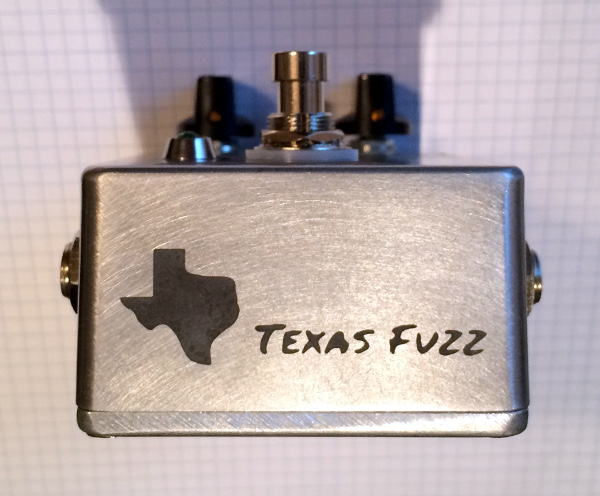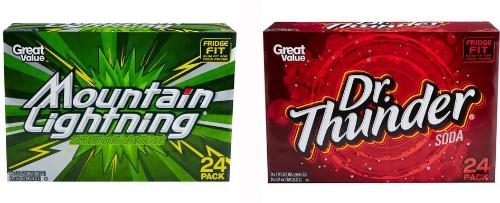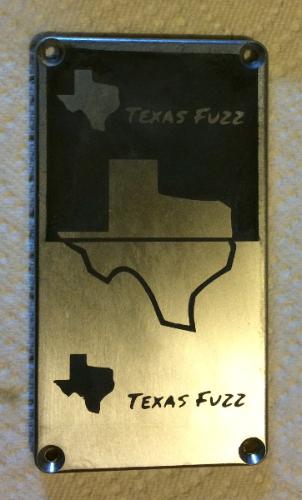Enclosure etching using vinyl masks
12



12
|
This post was updated on .
If you have struggled getting good results etching enclosures, this may be something you are interested in.
I won't post the entire overview here, but I have finally achieved what I consider really good etching results on aluminum enclosures by using vinyl masks. I have tried the toner transfer method in the past with limited success. There was always an issue with the toner pitting, or the reversed image not being perfectly centered (since I was looking at it through the back of a glossy magazine), poor transfer of the toner, enclosures that weren't perfectly flat, etc. I have dabbled in many enclosure finishing techniques, but I have always preferred etching above all others. Well, on a random trip to Joann Fabrics (a craft store like Hobby Lobby, Michael's, etc.) I came across their electronic cutters. One of the mediums you can cut on them is vinyl. I figured if I could cut it "accurately" vinyl would be an awesome etch resist, and this cutter could do it. Anyway, here is the final product after using it to cut a mask. Basically you cut your mask into the vinyl, stick it on, apply ferric chloride (sold at Fry's and other electronics stores for less than $10 per bottle), rinse and you're done. It is by far the best etching I have ever done myself and there was no B.S. ironing of glossy paper to enclosures until they are burning hot. Here is the "bad" part...the cutters aren't cheap. Normally the one I bought is $250, but I got it on sale for $150. That being said, the vinyl sheets are pretty cheap if you want to simply hand cut your mask designs, stick em on, and then etch. I actually considered this technique but conceded that I would never be able to hand cut lettering that small. OK...here is the resulting etch test. If you want to see a high level tutorial, I posted it here. NOTE: The cutters can cut all kinds of stuff including, paper, cardstock, stickers, etc. Maybe if your significant other is crafty they would be open to letting you buy one to share with them.    NOTE: I initially used the original builder name and pedal name in my first etching tutorial that was linked above. I pulled that pic after some discussions about it further down this post but left the other two as an example of the etch quality. I also removed that etching tutorial that was originally linked, but it has now been replaced with a new one (linked above). Sorry guys!!! |
|
Administrator
|
Neat idea man. The only downside I see to this method is that you can only do reverse etching with this. If you want to have most of the enclosure etched, but leave the image raised you can just peal and stick. But, I could see making the reverse etch and using it as a mask/stencil and coat the visable areas in an etch resistant coating, then peal the mask away. Which could be really nice as a near perminant stencil if you're doing a run of pedals. I've looked into these for something else, but went in a different direction for that project. This makes me want to look into them further. Btw, which one did you get?
|
|
I chose to etch the lettering and the image away for this one, but I suppose I could've just as easily peeled away the opposite pieces of the vinyl and etched away the majority of the enclosure top which would leave the lettering and image raised.
I doubt I'll ever need to make the same thing twice, so I never really considered making multiple runs. That being said, the image mask is saved so I could reprint it and use it again if I needed. The cutter I got was the Cricut Explore. I'm working on a few other layouts now, maybe I'll try and do a reversed raised version of one. I'll let you know how it goes. |
Re: Enclosure etching using vinyl masks
|
Nice work; I really like it!
And another gadget to use too! Who doesn't like another gadget? If the results are consistently good then it could be a worthwhile purchase. (Off to check ebay now for used ones!) My wife is a hobby card maker too, so it would get use other than just for my pedals. |
|
Administrator
|
In reply to this post by texasfuzz
This is a great post! Thanks for sharing!!
You could also use this thing to finish your pedals in vinyl the way Dr Scientist used to. I had a V2 Cosmichorus and the vinyl artwork was super cool. One thing that I want to say is that it's a major faux pas to use the original designer's brand and model name in the graphics of your clone. The fact that you're using another builder's circuit is probably going to bother them, the fact that you used their brand and model name is something that they could actually prosecute if you sell these. Even if you don't sell them, it's just not cool. Please don't use any layout that I post in this fashion. I really hate to be the prick, especially because this is an otherwise brilliant and much appreciated post. But trademark infringement brings us all down |
|
NOTE: Upon reading Travis' reply above, I edited the original post to remove the pic in question. I also pulled my etching turorial from my site for the moment since it used the image in question as its example - I'll create a more detailed tutorial in a day or two to replace it though.
Now on to my response... Hi Travis, I understand what you are saying, and I have always been quite conflicted when it came to the "artwork and labeling" portion of anything I have built. So much so, that I have put off enclosing close to 100 builds for this very reason. I had told myself before posting that if anyone brought the topic up, then I would take it as a sign that I need to find a different avenue for labeling enclosures before I make another one. Initially I had resolved to call everything by its manufactured name with the word "clone" added to it. It made the titles pretty long for some but I could still more or less fit them neatly into my layout parameters for etching. Then I had also considered no labeling, but then I'd be unable to keep them all sorted myself. I considered calling them A, B, C, etc., but then I would need some sort of table of contents next to my pedal board probably. I considered a notation on the back or side that stated this is cloned from "insert creator here" and has been created for my own personal use, etc. I guess my question is - and maybe I should post it as a new topic for others to chime in - what is the general consensus on artwork and labeling for clones? Is there a good way to clone another builder's pedal for personal use, create some artwork for it, and show it to others with good intentions and no desire to profit from it - but do it without infringing upon their rights? My current thought is that I should simply choose artwork that represents the circuit in such as way that that I know what it is without needing labels. At the same time I can also credit the original designer on the side or back (like I do in each post I make for my builds). Thoughts? |
|
Texasfuzz, this issue is plain black and white - no grey areas here.
Copying the artwork and/or logo of any product or brand name (not just effects pedals), is a clear breach of trademark and/or copyright law, and anyone doing so is liable to be taken to the cleaners in court. NO amount of added wording such as "Clone" or your own logo on the back, sides or top will get around this. Please take a look through the builds in the "Show us your pedal guts" thread - there are more than thirty pages of great original artwork and labelling, in a variety of mediums, from handpainted, acid etched, stencils, label printers, decals and others - even plastic dog turds! And all on "clone" pedals. |
Re: Enclosure etching using vinyl masks
|
In reply to this post by texasfuzz
Ironically, i was at michael's this weekend and saw this exact cutter on the shelf and had the same idea as you...
The only question i had (and nobody there could tell me) was how fine can the details be that are cut into the vinyl? |
|
In reply to this post by Beaker
This is more of a legal comment than an ethical one, and applies specifically to the US:
While it is illegal to duplicate artwork and written copy without permission (even for personal use), it is not illegal to print the name of the thing being copied on something made for personal use. The difference is that product and brand names are protected by trademark law, which has a non-commercial use exemption, while artwork is protected by copyright law, which does not. Logos are often both artwork (assuming a minimum level of distinctiveness) and brand identifiers, and as such are often covered by both trademark and copyright law. So printing a protected logo on a personal build is illegal, but printing the name is not, as long as the pedal is not used 'in connection with a good or service.' That last bit can be interpreted differently by different people (including judges), so beware. In addition, product and brand names can be used in connection to commercial activities, as long as there's no misrepresentation or risk of confusion about whether the object is or is not affiliated with the named brand or product. Otherwise, negative reviews or journalistic references would be punishable, which is explicitly allowed by the law. The same law specifically allows for comparative advertising. The magic words are some variation on 'Compare to...' For example:  Regarding the OP, your use of the the brand and product name on your build seems to be legal (I Am Not A Lawyer), as long as you doesn't sell it or use it for marketing or other commercial activities. However, navigating the complexities of copyright and trademark law is not easy, even for copyright and trademark attorneys. Whether a specific use is allowable is often hashed out in court, so I suggest you err on the side of caution. Being sued is an expensive PITA, even if you win. A different, very common approach (in pedals as well as other products) is to change the name and artwork just enough that it's not a copy, but it's still obvious what it's based on. For example:  All that being said. Most of the controversy about this issue in the pedal world is based more on cultural norms and ethics than on the law. If you cross the line, it's less likely that you'll get sued than that people will hate you. Of course, if you sell pedals, this can have a huge impact on the viability of your company. Crowds are often not especially rational or predictable, so one guy may get a pass while another guy gets a pile-on. Such is life. I don't sell my builds, so I really couldn't care less about most of this. Even so, I never print anything on the outside of my builds, including labeling the controls. This is mostly because I want them to look nice (no Sharpies), but I'm more interested in the circuits than the visual design (i.e. I'm lazy, so no etching, waterslides, or even painting). It's true that I sometimes turn on the wrong pedal or turn the wrong knob, but my mistakes are often more musically interesting than what I was trying to do in the first place, so I don't mind. |
|
In reply to this post by Beaker
Hi Beaker,
I agree with you when you say "Copying the artwork and/or logo of any product or brand name (not just effects pedals), is a clear breach of trademark and/or copyright law, and anyone doing so is liable to be taken to the cleaners in court." That is pretty black and white. That being said, I didn't copy any original artwork, logos, lettering / fonts, etc. What I did do though was use the name of the original pedal on mine. After looking at 36 pages of guts and finishes a moment ago, it seems that many of the pedals posted there have done the same. That makes me think that when it comes to using the original name - it isn't really black or white for many people. Anyway, I spent a bit of time thinking this topic over throughout the day, and what I have taken away from this is... Moving forward, I plan to simply etch an image of something that seems to fit with the effect on top of my enclosures, no names necessary (original or made up). I should've considered this a bit more before building that one, but I didn't. This should ensure I never find myself having this conversation again. Finally, thanks for your feedback. I don't take this topic lightly and I will be steering clear of this situation in future builds. I'm just glad I got the feedback on my first etching instead of my 50th. |
|
In reply to this post by Sensei Tim
Hi Sensei Tim,
So far, I would say that it seems to be able to get pretty detailed. I haven't done a font test or anything, but I have cut a few "intricate" lines in the vinyl - definitely as good or better than I had hoped for. Using the clear carrier sheet to transfer it after removing any of the "negative parts" keeps it nice and intact as you move it around. Block lettering or something with some meat on it would definitely be better than script or thin curvy stuff for sure. For fine details, we are working on pretty small canvases to start with so, I guess a balance must be found. It's accepted the challenges I have thrown at it so far though. The resistance of the vinyl to the etchant is great. This is really the thing I appreciate about the process. No pitting, crappy transfers, hot irons and enclosures, etc. You get to work in an image that isn't reversed and clean up is as simple as a quick rinse of the etchant and peel the mask (which comes of extremely easy). |
Re: Enclosure etching using vinyl masks
|
You're doing a kiss cut on the vinyl, right?
you peel the backing carrier off as you stick it onto the enclosure surface? I would also assume that this would be awesome for PCBs, too! I'm so tempted to pick one of these up. The wife is a die hard crafter and she has a 40% off coupon from Michaels.. i don't think i would have to twist her arm too hard for her to be on board as long as she can use it ;) On Wed, Feb 3, 2016 at 4:02 PM, texasfuzz [via Guitar FX Layouts] < ml-node+s42897n27771h18@n6.nabble.com> wrote: > Hi Sensei Tim, > > So far, I would say that it seems to be able to get pretty detailed. I > haven't done a font test or anything, but I have cut a few "intricate" > lines in the vinyl - definitely as good or better than I had hoped for. > Using the clear carrier sheet to transfer it after removing any of the > "negative parts" keeps it nice and intact as you move it around. > > Block lettering or something with some meat on it would definitely be > better than script or thin curvy stuff for sure. For fine details, we are > working on pretty small canvases to start with so, I guess a balance must > be found. It's accepted the challenges I have thrown at it so far though. > > The resistance of the vinyl to the etchant is great. This is really the > thing I appreciate about the process. No pitting, crappy transfers, hot > irons and enclosures, etc. You get to work in an image that isn't reversed > and clean up is as simple as a quick rinse of the etchant and peel the mask > (which comes of extremely easy). > > > ------------------------------ > If you reply to this email, your message will be added to the discussion > below: > > http://guitar-fx-layouts.42897.x6.nabble.com/Enclosure-etching-using-vinyl-masks-tp27702p27771.html > To unsubscribe from Enclosure etching using vinyl masks, click here > <http://guitar-fx-layouts.42897.x6.nabble.com/template/NamlServlet.jtp?macro=unsubscribe_by_code&node=27702&code=VGdvcmphbmNAZ21haWwuY29tfDI3NzAyfDIzMDA3MzU0NQ==> > . > NAML > <http://guitar-fx-layouts.42897.x6.nabble.com/template/NamlServlet.jtp?macro=macro_viewer&id=instant_html%21nabble%3Aemail.naml&base=nabble.naml.namespaces.BasicNamespace-nabble.view.web.template.NabbleNamespace-nabble.view.web.template.NodeNamespace&breadcrumbs=notify_subscribers%21nabble%3Aemail.naml-instant_emails%21nabble%3Aemail.naml-send_instant_email%21nabble%3Aemail.naml> > |
|
In reply to this post by texasfuzz
While I totally accept your point that you did not copy the artwork for your clone, the issue Travis raised is that you used the manufacturers name and the pedals "model" name, on a clone that you may intend to produce as a commercially available pedal.
It would be the same as if you you made a clone of a Fulltone OCD and printed "Fulltone OCD" on it. Even if you changed the font, you are asking for a lawsuit. Call it something like the "Texas Disorder Drive", and you are good to go. As Induction said, if you build them for yourself, that's one thing, but if you intend to sell your pedals, you do have to be careful. |
|
Sorry Beaker, I never really made it clear - I have never sold a pedal and I never intend to. I'm a pedal hoarder, and DIY effects is just a hobby I really enjoy.
The absolute last thing I ever want to do is make someone feel like I have ripped them off, that is definitely not my intention. It probably didn't help my case though that it was a more recent model as opposed to a fuzz face or something from way back in the day. I get what you and Travis are saying though, and all points made are right on. Thanks again for looking out. I hope I can make up for this initial stumble with some legit contributions moving forward. |
|
In reply to this post by Sensei Tim
Tim,
If you're wife is into crafts, then I'd definitely go for it. You can make some rad "Sensei Tim"stickers with it too and stick them all over town! I was also thinking it could be great for PCB's, but I'm not sure how small the lines can be made yet. Something simple with ample spacing of line work like a fuzz might work pretty well though. Regarding the application of the mask I replaced the original etching walk through with a new one a few minutes ago to show the steps. That can be found here if interested. I tried to demonstrate normal and reverse etching. The top is unetched lettering with most of the surface etched away, the bottom is etched lettering. The depth is quite shallow in this example because it's pretty cold in my garage and the ferric chloride reaction tends to slow the colder it is. 
|
|
Administrator
|
just one point about making clones in general, and to add to beakers comment about some builders that get all up in arms. if you ever make a fooltone clone, i think you know who i'm talking about, some pro builders are very sue happy, even if they are in the wrong. fooltone in particular goes so far as to have any eBay listing removed if OCD is mentioned even as a comparison. hell, he actually forced a company from changing their pedal name that had the same initials, and yes it was a modded OCD.
also, just to add, i think the ethical issue people in the DIY community have is when builders claim they have something new or when a goops a board to hide the circuit, when it's just a clone or slightly modded of an existing pedal. i think it's about honesty, and being honest with those you sell to. example, if you're selling a BMP clone, just say it's based on "_______" generation BMP. btw, in the case of the fooltone, he made his name with the OCD, which was gooped as it was "new," when it was nothing more then a Voodoo Lab OD. not to mention him claiming rights to parts of pedal designs, when they were published by known DIYers way before him, but that's a whole nother story. |
|
In reply to this post by texasfuzz
Whether you stumbled or not is open to discussion, but rest assured your contribution was legit. |
|
Administrator
|
Agreed. I didn't mean to rain on the parade. This is a very well constructed, much appreciated post |
|
Administrator
|
2nd. There had only been one time that it was a major issue, and it wasn't at all because of a discussion. Trust me, it's no biggy. Happy you're hear and post, so keep them coming man.
|
|
I agree too, your contribution is more than welcome, and your Vinyl mask idea is a great one.
I mis-interpreted your intententions to some degree, as most guys who go to the trouble of designing themselves a logo for their enclosures, do so because they wish to sell their pedals. The faux pas you made was out of innocence and ignorance, which is understandable, and more importantly, easily put right. As Rocket pointed out, some builders patrol ebay, Craigslist, Etsy etc. looking for similar hapless victims as yourself. I hope you enjoy yourself here. 
|
«
Return to Open Chat
|
1 view|%1 views
| Free forum by Nabble | Edit this page |

